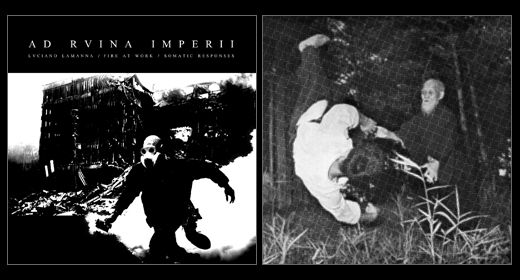Gestell (roughly ‘enframing’) is a term coined by German philosopher Martin Heidegger to describe what lies behind modern technology. Ge-stell is also a new label run by Cameron Shafii, presumably seeking seepage of some of the term’s semantic caché into the roster, represented here by post-digital wild frontiersmen, Dalglish and Brandon Nickell, with two inaugural releases.
Chris Douglas has been active in the experimental electronic music world for two decades, though you may not know it. He has about him an Outsider air—a single-minded soul, hard to envision DJ-/party-ing in early-90s SF with the likes of Jonah Sharp (Spacetime Continuum), Mike Banks (Underground Resistance) and James Stinson (Drexciya). First clear spot on the radar was in 1992 as O.S.T. with Basilar, a prescient contribution to the convergence of vectors towards IDM. Mid-90s remix album, rEMIT rECAPS, had him alongside Autechre, who co-opted him onto the Confield tour and ATP festival curation. The last decade has been low profile-wise, a ‘tragic event’ prompting a move to Berlin where he’s remained since. The Dalglish alias was first assigned to otJohr (2004), then Ideom (2008), and Benacah Drann Deachd (2011). ICASEA commemorated his 20 years with Bardachd/Auen Ansici (2012), a 4-track EP and ltd. double tape under anagrammatic alias Scald Rougish. Thus, under various monikers via a sui generis collision of DSP techniques and bitcrushed ‘scape-age a formidable oeuvre has built up, recently topped by Niaiw Ot Vile (PAN).
Now we have Dorcha Aigeann, an EP for Ge-stell, a tempered breakage of machinery via electro-acoustic tone-wrangling wherein the notion of a center, let alone the center, not to mention anything that might hold, does not exist in its DSP-arate tangle of splintering arrhythmicity and torn texture. First encounter, as with much of his work, is intense, at times overbearing, even intimidating, seemingly wilfully cryptic, but some kind of narrative may be retrievable by the more questing deconstructionist. Opener “Aois” layers drones into metallic plates that tilt and shift into new forms, strafed with concrète-esque tones highlighting alien terrain. Next up, “Onair” is more disorientating, blasted with static and noise, teeming with ravaged metals and distressed strings. “Uisge” is a more sub-aquatic setting teeming with particulate forms in Brownian motion. “Aonaich” is a labyrinthine lurch of fizzing fantasy and frenzy whose mode of construction is as ineffable as its realization. “Gsm Intv 4” is a smaller more perfectly formed darker ambient vignette of haunting resonance. The EP closes with “Mrin,” a miasma of shape-shifting collision and dislocation, bleep and pulse, crash and burn.
Dorcha Aigeann is an unfeasibly complex insight into a virtual world of creaking, groaning, sparkling sonicity. Repeat listens may yield further findings. ‘When you gaze long into an abyss, the abyss also gazes into you.’ (Ge-stell)
Dorcha Aigeann is available on Ge-stell.
After the DSP-erate depredations of Dalglish, Brandon Nickell’s Skyline is distinctly easier listening—beat programming, at least, in regular tempo, though by no means rude mechanical, though the Nickell lowdown is lower than our background dig on Douglas. Ge-stell does tell (here) of a long-standing interest in computation models and in engineering simulations with algorithmic overlays, and of earlier years in which the artist courted familiarity with electronic adepts via his Isounderscore label, hosting releases for various luminaries as well as himself, incl. a (now defunct) noise project, Aemae. His current productions manifest as if continuous functions of open source programming situated at an acid-tinged hiphop-inflected post-industrial intersection of IDM, a weft woven with a warp not far from that of mid-period AE.
“Bayes” sets out, propulsive and percussive, with a high-end organ-like sustain running through it buffeted by diverse dynamic vectors. “Norvig Trajectory” glowers winningly from within a prevailing darker-hued tenor evoked by a deep oscillating drone, effectively offset by a stark skeletal beat. “Tesselate” alludes to serialism, synth lines spooled out and plied into befogged sequences, both at the center and the periphery, over a simple snare-splat and bomp.
Overall, Skyline finds Nickell managing to place what once was, chipping away at Electro and Ambient tropes, next to other players making their discreet entries and exits, cadences and cascades, in the spaces in between—to create something other.
Skyline is available on Ge-stell.



























